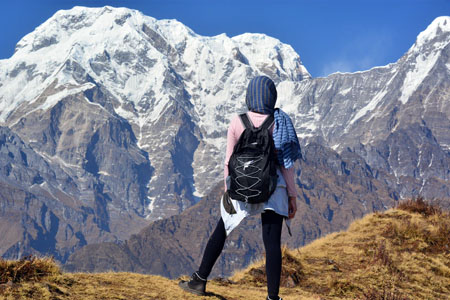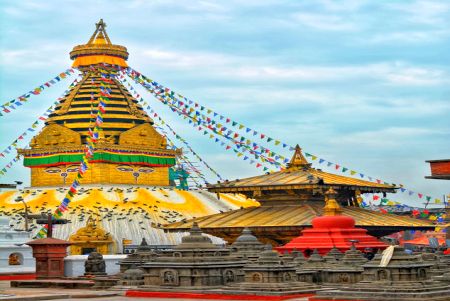Colors of Nepal
Kathmandu - Pokhara - Kathmandu
Duration
6 Days
Tour Type
Tour Package
Group Size
Min. 2 persons
Location
Nepal
Overview
Embark on an unforgettable 6-day journey through Nepal, blending spiritual heritage, thrilling wildlife, serene lakes, and Himalayan panoramas. Begin in Kathmandu, Nepal’s cultural capital, where you’ll visit sacred sites like the Pashupatinath Temple and Bouddhanath Stupa. Explore Patan’s ancient architecture and the hilltop Swayambhunath Stupa, watching over the valley with the iconic eyes of Buddha.
Travel to Chitwan, home to Nepal’s first national park and a UNESCO World Heritage Site. Enjoy nature walks and an elephant safari through dense jungles teeming with rhinos, crocodiles, and vibrant birdlife. Then, continue to picturesque Pokhara, where the Annapurna range reflects in serene lakes. Discover the Bindhyabasini Temple, Davis Falls, and Gupteshwar Cave.
Finally, ascend to Nagarkot, a peaceful hill station offering breathtaking sunrise views over the Himalayas, including Mount Everest. This thoughtfully curated tour captures Nepal’s best its culture, nature, and spectacular scenery in one remarkable experience.
Travel Category
Inclusions
Kathmandu Airport Pick & Drop
Hotel accommodation on twin sharing basis
Breakfast & Dinner include
All ground transportation by private vehicle.
Sightseeing as per above itinerary.
All government taxes, VAT, Tourist Service charges and official expenses.
Exclusions
Any international & Domestic airfare
Lunch not include
Professional Tour guide assistance.
Any monument & Activity Charges
Bar bills and Personal Expenses.
Tips and gratitude.
GST & TCS EXTRA
Itinerary
FAQs
Terms & Conditions:
Do I need a visa to enter Nepal?
What is the best time to visit Nepal?
Is Nepal safe for tourists?
What are the must-visit places in Nepal?
What kind of accommodation is available?
Do I need to hire a guide or porter for trekking?
What should I pack for a Nepal tour?
What currency is used in Nepal?
Is internet and mobile connectivity available?
Are there any cultural dos and don'ts?
What kind of food is available in Nepal?
Do I need travel insurance?
How do I get around within Nepal?
What languages are spoken in Nepal?
Is tipping expected in Nepal?
Tour Location
Travel and Package Info
- Booking & Confirmation
- Bookings are confirmed only upon receipt of the required deposit.
- Full payment must be made before the specified deadline to avoid cancellation.
- Failure to pay the balance on time may result in cancellation without refund.
- Pricing
- Prices are quoted in INR and are subject to change without prior notice due to changes in taxes, fuel surcharges, exchange rates, or other unforeseen circumstances.
- The package price includes only those services specifically listed.
- Inclusions & Exclusions
- Inclusions typically cover transportation, accommodation, sightseeing, entry tickets, and meals as mentioned in the itinerary.
- Exclusions may include personal expenses, visa fees, travel insurance, and optional tours.
- Cancellations & Refunds
- Cancellation charges apply as per the schedule shared at the time of booking.
- Refunds, if applicable, will be processed within 20 days after cancellation, less any applicable charges.
- Changes by the Traveler
- Any changes requested after confirmation may incur additional charges.
- Changes are subject to availability and operator approval.
- Changes by the Tour Operator
- The operator reserves the right to modify the itinerary, accommodation, or transportation due to unforeseen circumstances (weather, strikes, etc.).
- Any such change will be communicated promptly, and alternatives of equal value will be provided.
- Travel Documents
- Travelers are responsible for carrying valid Aadhar card, passports, visas, vaccination certificates, and any other required documents.
- Insurance
- Travel insurance is highly recommended and may be mandatory for some packages.
- The operator is not liable for any loss, injury, accident, or damage not covered under insurance.
- Liability Disclaimer
- The tour operator is not responsible for any delays, injuries, losses, damages, or expenses due to natural disasters, political unrest, flight cancellations, or other events beyond their control.
- Health & Fitness
- Travelers should ensure they are physically fit for the tour. Certain packages may not be suitable for those with health conditions or mobility issues.
- Conduct & Behavior
- Travelers are expected to behave respectfully. Any misconduct may result in removal from the tour without refund.
- Complaints & Disputes
- Any complaints should be reported immediately during the tour.
- Disputes shall be governed by the laws of Delhi and subject to the exclusive jurisdiction of courts in Delhi.
Extra prices:
- {{total_price_html}}
- {{pay_now_price_html}}





